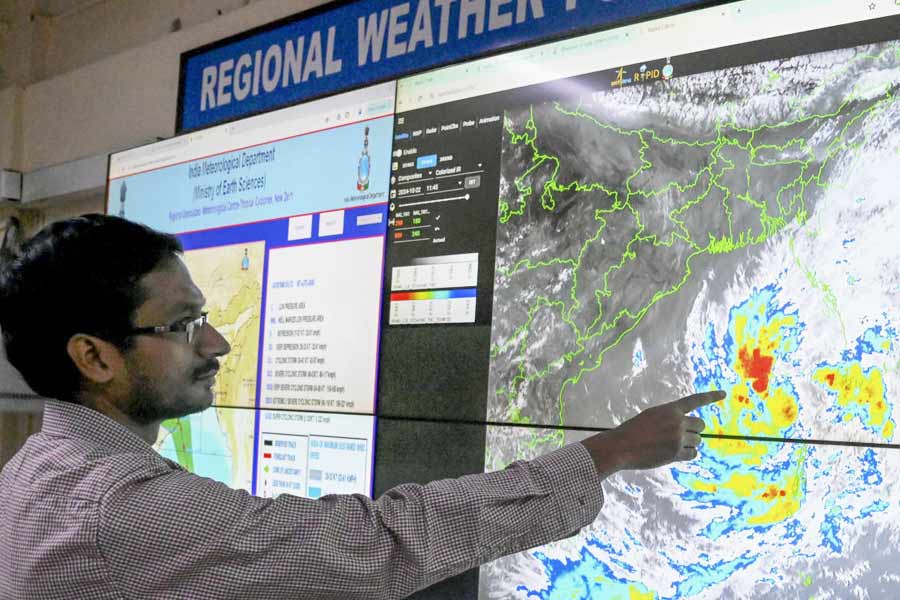In the 1990s, the Met office would issue a cyclone alert only 24 hours in advance, when the storm would rage not far from land.
Now the IMD predicts a cyclone’s path days in advance, even when the precursor to the storm is a spec deep in the sea.
The strides that the Met office has made in extreme-weather forecasting capability was the talking point of a Friday workshop held in the run-up to the 150th birthday celebrations of the India Meteorological Department.
The IMD will turn 150 on January 15, 2025.
“The Kandla cyclone (it struck Gujarat’s Kandla port in June 1998) sank over a dozen ships and killed some 4,500 people because forecasting was not up to the mark. In 1999, the Odisha super cyclone killed 10,000 people,” said Mrutyunjay Mohapatra, director-general of meteorology, IMD, who was present at the workshop at the Geological Survey of India.
“Compare the toll back then with the toll now. The primary objective is to save lives. This was made possible by improving the early-warning system. That is the key. Earlier, we could forecast 24 hours before a cyclone. Now, we give a genesis forecast, days in advance. We are predicting a cyclone long before it becomes one,” he said.
Dana, the cyclone that hit Odisha in October, caused zero deaths in the state.
A disastrous tropical cyclone struck Calcutta in 1864 and it was followed by acute monsoon shortfall in 1866 and 1871.
“In the year 1875, the Government of India established the India Meteorological Department, bringing all meteorological work in the country under a central authority. Mr. H.F. Blanford was appointed Meteorological Reporter to the Government of India. The first Director General of Observatories was Sir John Eliot who was appointed in May 1889 at Calcutta headquarters. The headquarters of IMD were later shifted to Shimla, then to Poona (now Pune) and finally to New Delhi,” the IMD website says.
Even before the IMD was established in 1875, many observatories were already in existence and a system of telegraphically reporting the observations had been introduced.
This system was modified with the introduction of a new telegraphic weather code in 1875.
“Coded observations from 50 stations were collected every day for the publication of the Indian Daily Weather Report.... Seismological observatories were set up in Alipore in 1897, in Colaba (Mumbai) and Chennai in 1898-99,” the IMD website says.
The IMD started its journey from the Regional Meteorological Centre in Alipore. “So, the programme in Calcutta is special,” said Somenath Dutta, who heads the RMC.
On Friday, Mohapatra spoke of a change in the movement of cyclones. “The cyclones are moving slowly at the time of landfall. Earlier, a cyclone would take three hours to cross the coast. Now, it is taking more than five hours. The impact on the coast is more than before. Our socio-economic condition has improved over the years. People now own more assets than they ever did. That is why there is a rise in the loss of property. But because of the early-warning system, the loss of life has been drastically reduced.
“As of now, we don’t know why the cyclones are moving slower at the time of landfall. But in recent years, we have observed this pattern on the Pacific Ocean and the Bay of Bengal. What can this be attributed to, we still don’t know. It could be because of climate change. But we need evidence to establish any link,” he said.
Climate change
The frequency of localised extreme weather events is going up because of climate change.
“Earlier, rain would be uniform in a city. Now, Salt Lake gets rain but Alipore is dry at the same time. This trend will be more prominent in the coming days. The IMD is gearing up to meet the challenges of climate change. You cannot predict for the entire Calcutta based on observations in Alipore and Dum Dum. You need more weather stations, more rain gauges and radars,” Mohapatra said.
The number of radars in the country is set to be increased from 39 at the moment to around 120, he said.
“We want to have an observatory every 4km in metro cities. Every panchayat will also have a weather station. The ministries of earth sciences, rural development and agriculture are working together on this,” said Mohapatra.
M. Ravichandran, secretary, Union ministry of earth sciences, under which the IMD functions, and Dushyant Nariala, additional chief secretary of the Bengal government, were present at the workshop.










